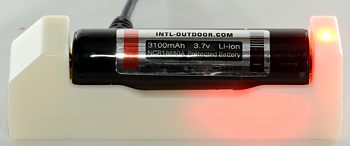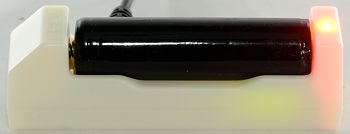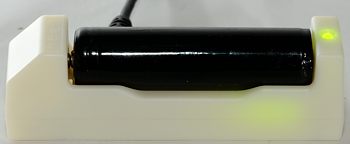Charger ML-102
I have published an updated review for V7.1 of this charger

This charger is a very small 18650 charger, it need an external USB power source to charge, and can also work as a USB charger. It only charges one battery at a time.

Only a USB cable is included with the charger, I did also order some spacers, making it possible to charge smaller batteries.


The charger is powered from any USB source that can supply 1A, sadly it uses the mini and not the micro USB connector (The micro USB is much stronger and is the common charge connector on phones). Because the connector is on the side of the charger it is not possible to place a couple of these chargers beside each other.

The charger also has a full size USB connection for power out, it can be used to charge a phone or other USB equipment.




The charger has a couple of leds, one is placed on top of the charger and some other inside the charger.
The light is red when charging, both red and green when nearly full, green when finished and blue when supplying USB power.


The plus connection is slightly raises, making it possible to charger flat top batteries, the spring at the minus connection is rather short, but long enough to support unprotected 18650 batteries.

With the two spacers (Each 15.9 mm long) I included in my order the charger can also handle xx500 and xx340 cell, but the charger current is too high for many of these batteries.






The charger can handle 69.6 mm long batteries, including flat top cells. Not all 26650 can be charged, it depends on the size and shape of the plus pole on the battery. With the spacers it is also possible to use smaller batteries, but watch the maximum charge current for the battery type!
Measurements
Below 2.8 volt the charger charges with 130 to 170 mA (Highest current at lowest voltage).
Between 2.8 volt and 4.2 volt the charger is applying regular charge current (See curve below).
When the charge current goes below 70mA the charging is stopped and it will discharge with less than 75 uA.
The charger will restart when the battery drops to 4.12 volt or power is cycled.
Reinserting the battery will not restart charging.
When charger is disconnected from power, but with a battery in, it will draw below 75uA from the battery.
.png)
The charge curve does not look like a CC/CV charger, but the only disadvantage with this type of curve is the slower charge speed, the final result will be just as good as a CC/CV charger. The termination current is around 80mA, this is a good value.
The above curve is done with a USB power supply (or more correctly a lab power supply adjusted to 5 volt).
%20Vusb=PC.png)
Using a laptop as power supply does not change the charge curve significantly. The charger is using nearly 1A from the USB connector, this is more than allowed in the USB specifications, but nearly always works fine.
%20Vusb=4.5V.png)
What happens if a weak USB power supply is used or long cables, to simulate that I turned the power supply down to 4.5 volt. The charger continues to charge and stops when the battery is full, but it takes considerable longer time (nearly 10 hours).
.png)
The charger also handles my old IMR cell without any problems.
Measurements on USB power
The charger can supply USB power while discharging the battery. It is possible to connect a USB power supply to the charger and connect the charger to some USB equipment and charge both at the same time.
USB specification says the voltage must be between 4.75 and 5.25 volt, I have placed a yellow line at 4.75 volt in the charts.
.png)
The first curve is with a 20 ohm load, this gives a load current of 250 mA, the usb output stays exactly at 5.13 volt, until the battery is empty. It keeps a very good efficiency at about 90%.
The power is turned off when the battery is down to 3 volt and it does not turn on again when the battery voltage increases, this is a good design.
.png)
Reducing the resistor increases the current to 500 mA and drops the voltage to 5.1 volt (probably due to cable losses). The efficiency is still very good at 85% to 90%.
.png)
Reducing the resistor again increases the current to 550 mA, the efficiency is starting to drop now, but the voltage is stable.
.png)
This time I have increased the current to 650 mA and this is at the limit of the circuit, the voltage is not stable anymore, but it can still supply this current for two hours and stay within the USB specifications.
Conclusion
This charger is a very compact LiIon charger with dual functionality (Can both charger USB devices and 18650 batteries), the charging profile is good, but not optimal for speed. I can see two obvious applications for this charger, one is for people with only a few 18650 batteries, the other is in a travel kit, where the ability to charger USB equipment from an 18650 battery can be very useful.
I like this charger and is going to add it to my traveling kit.
Notes
Here is an explanation on how I did the above charge curves: How do I test a charger


















.png)
%20Vusb=PC.png)
%20Vusb=4.5V.png)
.png)
.png)
.png)
.png)
.png)